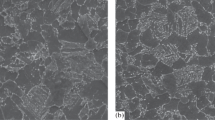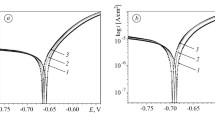Features of corrosion failure of the inner surface of a pipe extracted from the well of the Denzikul’ field (Uzbekistan) after 256 days of operation are studied. Corrosive environment: gas condensate under a pressure of 6.5–7.5 MPa, temperature of 60°C and density of 826 kg/m3 contained water with a total mineralization of 12.75 g/m3, hydrogen sulfide and carbon dioxide 3.5 and 4.76% (vol.), respectively. A fragment is cut out of the pipe at the inner surface that has through corrosion failure in the form of a triangle, at the base of which, apparently there is a manufacturing macro defect that propagates in the direction of gas condensate movement. Corrosion damage located along the perimeter of the triangle has two characteristic areas: uniform, close to a through hole, and intense corrosion. The width of each of the regions reaches 30 mm in the areas located at the apex of a triangle. The transition from uniform to intense corrosion is accompanied by formation of black protrusions 4–6 mm high and up to 3 mm in diameter, which collapse during transition into the area of general uniform corrosion observed over the rest of the pipe inner surface. The authors attribute features of the nature of corrosion damage observed to interaction of corrosion-active non-metallic inclusions (CANI) with gas condensate and an accelerating effect of hydrogen penetrating into steel on the corrosion process along with appearance and an increase in the level of triaxial tensile stresses in the vicinity of corrosion-active non-metallic inclusions.


Similar content being viewed by others
References
I. G. Rodionova, A. Yu. Zaitsev, O. N. Baklanova, A. V. Golovanov, N. I. Éndel’, É. T Shapovalov, and G. V. Semerin, Contemporary Approaches to Improving Corrosion Resistance and Operating Reliability of Steels for Oil industry Pipelines [in Russian], Metallurgizdat, Moscow (2012).
I. G. Rodionova, I. N. Baklanova and A. I. Zaitsev, “Role of non-metallic inclusions in acceleration of local corrosion processes of oil industry pipelines made of carbon low-alloy steels,” Metally, No. 5, 13–18 (2004).
A. I. Zaitsev, I. G. Rodionova, G. V. Semernin, et al., “New types of unfavourable non-metallic inclusions based upon MgO–Al2O3 and metallurgical factors governing their content within metal. Part I,” Metallurg, No. 2, 50–55 (2011).
A. I. Zaitsev, I. G. Rodionova, G. V. Semernin, et al., “New types of unfavourable non-metallic inclusions based upon MgO–Al2O3 and metallurgical factors governing their content within metal. Part II,” Metallurg, No. 3, 28–33 (2011).
M. A. Medvedeva, Corrosion and Protection of Oil and Gas Equipment During Oil and Gas Treatment [in Russian], Izd. Neft’ i Gaz RGU Nefti i Gaza im. I. M. Gubkina, Moscow (2005).
A. S. Guzenkova, I. V. Artamonova, S. A. Guzenkov, and S. S. Ivanov, “Steel corrosion in hydrogen sulphide containing model media of oil deposits,” Metallurg., No. 5, 36–39 (2021).
G. I. Kotel’nikov, D. A. Movenko, A. A. Pavlov, and S. A. Motrenko, “Model for distribution of tensile and compressive stresses within metal around castings containing non-metallic inclusions in aqueous media,” Izv. VUZ Chern. Met., 57, No. 3, 10–16 (2014).
E. S. Ivanov, I. V. Artamonova, S. S. Ivanov, and A. S. Guzenkova, “Low-alloy steel corrosion resistance in natural gas preparation production solutions,” Chemical and Petroleum Engineering, 53, No. 7/8, 547–550 (2017).
I. Yu. Pyshmintsev, I. V. Kostitsyna, D. A. Manannikov, V. P. Parshukov, M. Yu. Skryl’nik, and V. V. Zav’yalov, “Analysis of corrosion resistance of oil and gas pipelines from results of industrial tests in the Samotlor field,” Neft. Khozyaistvo, No. 3, 99–101 (2012).
A. V. Shreider, I. S. Shparber, and Yu. I. Arcchakov, Effect of Hydrogen on Oil and Chemical Equipment [in Russian], Mashinostroenie, Moscow (1976).
F. F. Azhogin, A. V. Sakharov, and S. S. Ivanov, “Question of hydrogen distribution in slow breakdown of high-strength steel,” Fiz. Khim. Mekhan. Materialov, No. 3, 35–38 (1979).
V. G. Starchak, “Effect of non-metallic inclusions in steel hydrogen embrittlement,” in: Hydrogenation of Metals and Alloys with Application of Metal Coating and Combatting Hydrogen Embrittlement [in Russian], MDNTI, im F. É. Dzerzhnskovo, Moscow (1973).
V. Rachinski and M. Smyalovski, “Effect of different factors on iron and steel hydrogen embrittlement,” Zashch. Met., 5, No. 5, 482–490 (1969).
É. M. Gutman, Metal Mechanochemistry and Corrosion Protection [in Russian], Metallurgiya, Moscow (1974).
Author information
Authors and Affiliations
Corresponding author
Additional information
Translated from Metallurg, Vol. 67, No. 8, pp. 90–93, August, 2023.
Rights and permissions
Springer Nature or its licensor (e.g. a society or other partner) holds exclusive rights to this article under a publishing agreement with the author(s) or other rightsholder(s); author self-archiving of the accepted manuscript version of this article is solely governed by the terms of such publishing agreement and applicable law.
About this article
Cite this article
Guzenkova, A.S., Artamonova, I.V., Guzenkov, S.A. et al. Features of Corrosive Breakdown of Pipe Steel in Gas Condensate. Metallurgist 67, 1187–1191 (2023). https://doi.org/10.1007/s11015-023-01610-4
Received:
Revised:
Accepted:
Published:
Issue Date:
DOI: https://doi.org/10.1007/s11015-023-01610-4




